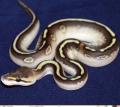» Site Navigation

0 members and 1,161 guests
No Members online
Most users ever online was 47,180, 07-16-2025 at 05:30 PM.
» Today's Birthdays

» Stats

Members: 75,917
Threads: 249,118
Posts: 2,572,202
Top Poster: JLC (31,651)
Welcome to our newest member, Necbov
|
-
Re: Trying to understand base morphs, help?
*edit*
i was thinking of the ember ball, sorry.
ember = sulfur, and flame = fire
-
-
Re: Trying to understand base morphs, help?
 Originally Posted by OhhWatALoser

couple i will disagree with, flame and sulfur i agree are the same thing (heck bought from the same pet store on the same day, why do they have different names?), but they tend to throw a way more patterned super than the super fire, then the lemonback super I have never seen one with any pattern at all. while the heterozygous form may be very close, the apparent consistency with the supers makes me say they are different.
orangebelly may be related to the graphite, ultra ivory stuff, last I heard ben still wasn't sure what was going on with that project. So I would label that one as different until further notice.
Here is a list of all of the proven complexes I know of http://www.owalreptiles.com/complexes.php many are considered the same tho, with what was already said, mystic = phantom, spector = whirlwind, banana = coral glow,
lori is normally thrown in with the het red, lace, and green pastel, even if none of them are proven to be compatible to my knowledge, tho we suspect them to be.
another thing to note is the 3 lines of axanthic, VPI, TSK, and Jolliff are all said to lay on different loci.
Thanks! It was your thread I was reading, and I was wondering if there were any updates to it.
Found this on your site too: http://www.owalreptiles.com/tradenames.php
Is that list up to date? Is it a list most of in the hobby will agree with?
Why keep a snake? Why keep any animal? Because you enjoy the animal, find something beautiful and fascinating about it, and it fits seamlessly into your lifestyle.
-
-
BPnet Veteran


Re: Trying to understand base morphs, help?
 Originally Posted by PitOnTheProwl

A good black pastel and cinny are like night and day 
As a breeder of both morphs, I completely agree.
-
-
Re: Trying to understand base morphs, help?
 Originally Posted by sorraia

Thanks! It was your thread I was reading, and I was wondering if there were any updates to it.
Found this on your site too: http://www.owalreptiles.com/tradenames.php
Is that list up to date? Is it a list most of in the hobby will agree with?
Up to date as far as my knowledge goes.
-
-
Re: Trying to understand base morphs, help?
 Originally Posted by sorraia

My background on this would be with rats, albino and colorpoint. The dominant allele on that locus is "full color", denoted "C". Color point is the "Himalayan gene", denoted "ch" and albino is "colorless", denoted "c". These alleles are in this order: C>ch>c, with C being dominant over both ch and c, and ch only being dominant over c. Although ch is considered dominant over c, it is actually incompletely dominant, where an animal that is chch is called a Siamese (an ideal, show quality animal would have strong points with darker shading over the body, giving more color to the background as well as the points), and an animal that is chc is called Himalayan (an ideal, show quality animal would have strong points but no shading, giving a whitish background as well as dark points). cc is of course albino and C- is any full colored animal (black, agouti, blue, etc). There are other genes on that locus, but I am not as familiar with the, nor are they as common as these three, so I have not included them in this description.
If that description made sense, is that how these "complexes" in ball python morphs work too? Orders of course would vary from one complex to another.
In other words, C is the normal (wild type) allele and the other two are recessive mutant alleles. And the chch allele is incompletely dominant to the c allele. I started mouse genetics. The mouse c locus has similar alleles that have similar dominance relationships.
Herpers have tended to make up words as they go along instead of using established genetics terminology. A complex is a set of alleles. Two mutant genes are compatible if they are alleles.
Don't expect a nice orderly series of dominance relationships like that rat example. Sometimes you get that, sometimes not. For example, both mojave and lesser are codominant to the normal allele, but mojave is recessive to lesser.
By the way, many genetics texts separate mutant genes that are not Mendelian dominants and recessives into subcategories like codominant, incomplete dominant, overdominant, partial dominant, semidominant, etc. For simplicity, we lump them all together under "codominant".
Last edited by paulh; 12-04-2012 at 08:48 PM.
-
The Following User Says Thank You to paulh For This Useful Post:
 Posting Permissions
Posting Permissions
- You may not post new threads
- You may not post replies
- You may not post attachments
- You may not edit your posts
-
Forum Rules
|